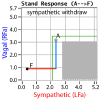Long COVID and the Autonomic Nervous System: The Journey from Dysautonomia to Therapeutic Neuro-Modulation through the Retrospective Analysis of 152 Patients
- PMID: 39483361
- PMCID: PMC11523758
- DOI: 10.3390/neurosci3020021
Long COVID and the Autonomic Nervous System: The Journey from Dysautonomia to Therapeutic Neuro-Modulation through the Retrospective Analysis of 152 Patients
Abstract
Introduction: The severity and prevalence of Post-Acute COVID-19 Sequela (PACS) or long-COVID syndrome (long COVID) should not be a surprise. Long-COVID symptoms may be explained by oxidative stress and parasympathetic and sympathetic (P&S) dysfunction. This is a retrospective, hypothesis generating, outcomes study.
Methods: From two suburban practices in northeastern United States, 152 long COVID patients were exposed to the following practices: (1) first, they were P&S tested (P&S Monitor 4.0; Physio PS, Inc., Atlanta, GA, USA) prior to being infected with COVID-19 due to other causes of autonomic dysfunction; (2) received a pre-COVID-19 follow-up P&S test after autonomic therapy; (3) then, they were infected with COVID-19; (4) P&S tested within three months of surviving the COVID-19 infection with long-COVID symptoms; and, finally, (5) post-COVID-19, follow-up P&S tested, again, after autonomic therapy. All the patients completed autonomic questionnaires with each test. This cohort included 88 females (57.8%), with an average age of 47.0 years (ranging from 14 to 79 years), and an average BMI of 26.9 #/in2.
Results: More pre-COVID-19 patients presented with sympathetic withdrawal than parasympathetic excess. Post-COVID-19, these patients presented with this ratio reversed and, on average, 49.9% more autonomic symptoms than they did pre-COVID-19.
Discussion: Both parasympathetic excess and sympathetic withdrawal are separate and treatable autonomic dysfunctions and autonomic treatment significantly reduces the prevalence of autonomic symptoms.
Conclusion: SARS-CoV-2, via its oxidative stress, can lead to P&S dysfunction, which, in turn, affects the control and coordination of all systems throughout the whole body and may explain all of the symptoms of long-COVID syndrome. Autonomic therapy leads to positive outcomes and patient quality of life may be restored.
Keywords: autonomic dysfunction; autonomic therapy; long COVID; outcomes; parasympathetic; sympathetic.
© 2022 by the authors.
Conflict of interest statement
Conflicts of InterestOnly Colombo has a conflict of interest as Co-Founder and Sr. Medical Director of Physio PS, Inc. No other individual associated with this manuscript has a conflict of interest.
Figures





Similar articles
-
Demonstrating new-onset or worsened sudomotor function post-COVID-19 on comparative analysis of autonomic function pre-and post-SARS-CoV-2 infection.eNeurologicalSci. 2023 Mar;30:100445. doi: 10.1016/j.ensci.2023.100445. Epub 2023 Jan 26. eNeurologicalSci. 2023. PMID: 36718227 Free PMC article.
-
Parasympathetic autonomic dysfunction is more often evidenced than sympathetic autonomic dysfunction in fluctuating and polymorphic symptoms of "long-COVID" patients.Sci Rep. 2023 May 22;13(1):8251. doi: 10.1038/s41598-023-35086-8. Sci Rep. 2023. PMID: 37217645 Free PMC article.
-
Long-COVID Syndrome and the Cardiovascular System: A Review of Neurocardiologic Effects on Multiple Systems.Curr Cardiol Rep. 2022 Nov;24(11):1711-1726. doi: 10.1007/s11886-022-01786-2. Epub 2022 Sep 30. Curr Cardiol Rep. 2022. PMID: 36178611 Free PMC article. Review.
-
Parasympathetic and Sympathetic Monitoring Identifies Earliest Signs of Autonomic Neuropathy.NeuroSci. 2022 Jul 13;3(3):408-418. doi: 10.3390/neurosci3030030. eCollection 2022 Sep. NeuroSci. 2022. PMID: 39483433 Free PMC article.
-
Dysautonomia in COVID-19 Patients: A Narrative Review on Clinical Course, Diagnostic and Therapeutic Strategies.Front Neurol. 2022 May 27;13:886609. doi: 10.3389/fneur.2022.886609. eCollection 2022. Front Neurol. 2022. PMID: 35720084 Free PMC article. Review.
Cited by
-
The interplay between Sars-Cov-2 infection related cardiovascular diseases and depression. Common mechanisms, shared symptoms.Am Heart J Plus. 2024 Jan 18;38:100364. doi: 10.1016/j.ahjo.2024.100364. eCollection 2024 Feb. Am Heart J Plus. 2024. PMID: 38510743 Free PMC article. Review.
References
-
- DePace N.L., Colombo J. Long-covid syndrome: A multi-organ disorder. Cardio. Open. 2022;7:212–223.
-
- DePace N.L., Colombo J. Long-COVID syndrome: A review of what we have learned clinically to date. 2022. Submitted .
-
- DePace N.L., Colombo J. Autonomic and Mitochondrial Dysfunction in Clinical Diseases: Diagnostic, Prevention, and Therapy. Springer Science + Business Media; New York, NY, USA: 2019.
-
- Colombo J., Arora R.R., DePace N.L., Vinik A.I. Clinical Autonomic Dysfunction: Measurement, Indications, Therapies, and Outcomes. Springer Science + Business Media; New York, NY, USA: 2014.
LinkOut - more resources
Full Text Sources
Miscellaneous

